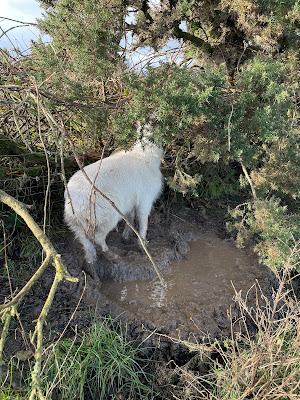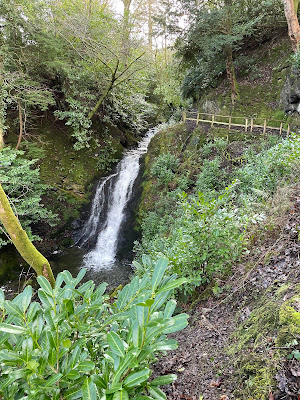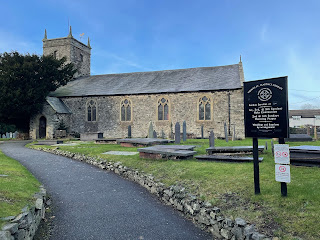 |
| Been stuck here for days - help! |
A brighter morning to start with and we had a pleasant climb out of Gwytherin up a lovely path in a wooded valley, all good so far. Skip and I encountered a couple of fallen trees which we spent a bit of time skirting round. Then, as we crested the top of the hill the heavens opened - we got wet....and muddy. Tramping over a moorland plateau I realised I'd been wise to pack dry socks. A quick downhill and a short road section saw us onto some very wet fields. I keep Skip on the lead when there are sheep around but let him off otherwise - and there we were, in a flourishing green field with no sign of grazing animals, I spotted movement in a hedge. A young but large lamb was standing in a big muddy puddle with its head stuck in fencewire; its backwards facing horns were preventing any escape. I extricated it with some difficulty and it bleated at me with gratitude, its backs legs sank to the ground and it started munching on a big tuft of grass. Clearly it had been there for some time - we were nowhere near a farmhouse so I had to leave it to fend for itself. Having kept sheep in the past I was confident that it would recover and retain a memory of that gallant pilgrim who had saved its life.
 |
| Pandy Tudur - anyone here called Andy? |
We headed onwards through a small village going by the name of Pandy Tudur, the word Pandy referring to the fact that there was a pre industrial woollen mill here. At this point the rain stopped and the village was bathed in sunlight. The largest building seen here is the Bethania Calvinist Methodist Chapel. Unlike Amglican and Catholic churches, which are generally named after saints, Methodist chapels are named after biblical locations and Bethania or Bethany is just a couple of miles outside Jerusalem - it's where Jesus raised Lazarus from the dead. Out of Pandy Tudur we climbed along past a farm on the outskirts of the village and were serenaded by half a dozen collies who raced backwards and forwards on the other side of a fence clearly trying get a rise out of Skip, but to no avail, Skip ignored them and we carried on up and over the hill.
 |
| Anyone at home? |
I had seen that the map indicated an old vicarage was coming up on our right. So by a vicarage you'd expect a church and indeed here is a church, but it's a church no longer. I've been unable to find out much about it apart from the fact that it was built in 1867, which leads me to wonder who built it and who were the congregation, seeing as this was sited well away from the village. By the front gate is a wooden sign with St David's Lodge written on it so presumably that was to whom the church was dedicated. Next door is a large ruined vicarage which functioned as a nursing home until 2019 when it burnt down. The local fire brigade did well to get all the residents out without any major casualties!
 |
| Bring me chainsaw next time! |
We'd been making fair progress at this point but our hopes of keeping going at a fair lick were dashed as we negotiated a woodland riverside path by the grounds of Hafodunos Hall. The hall, one of the most majestic residential buildings in Wales, was burnt down in 2004 but is currently being rebuilt; we'll have to go and take a look when it's completed. We trotted along comfortably on a well defined path, turned a corner and came face to face with this - a mass of trees had fallen directly across our way. We tried going up and round with no success, Skip getting snarled up in the tangled undergrowth. Eventually we backtracked to a fordable crossing point through the river and made our way round. This whole episode had cost us nearly half an hour.
Back on the trail we picked up our heels and to help us on our way we were pointed in the right direction by a kindly old woodman:
 |
| It's this way buddy! |
 |
| Gurgle! |
Heading into Llangernew we tracked the river further downhill and were rewarded with a pleasant amble through mature woodland spotting a gushing waterfall to our right. We passed the old hall gatehouse and trotted down the road. I had already realised that there was a lot to see in Llangernw, including the North Wales Pilgrims' Way Hub, and St Digian's Church with a 4000 year old yew tree in its graveyard. With little time to spare I decided to consign all this to a future visit and we stuck to the Pilgrims' route and galloped up the hill just before the village. At the top of a short climb a big metal gate barred the way forward. It wasn't padlocked but it might as well have been. A tightly knotted rope secured gate to post and no amount of teasing could unravel the contorted tangle. So for maybe the fourth time today I lifted Skip up and heaved him over.
 |
| St Martin was here! |
From the final peaks of the day we could see Snowdonia in the distant west, on a clearer day this would have been a magnificent sight as we descended down the steep tracks and roads into Eglwysbach. We passed Coed Annie (no idea who Annie is or was) and along the Afon Hiraethlyn onto our final rendezvous outside the Bee Inn, a fine looking pub. It's now the only pub in town but a hundred years ago there were plenty - in 1909 there was an objection to the renewal of the licence for the Bodnod Arms next door on the grounds that there was currently one pub for every 185 inhabitants, the pub failed to have its licence renewed but it then became the Aberconway Institute for use by the community, courtesy of the owner Lady Aberconway. I finished the day outside St Martin's church close to the Bee Inn. No dogs allowed inside the pub though - maybe we can come back in summer and have a pint in the beer garden, the beer should be good - each week the locals select a guest ale of their own choosing to sit on the bar next to the Bee Inn Bitter.
























